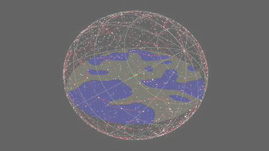Teachers' Domain - Digital Media for the Classroom and Professional Development
User: Preview



Animations and essays were created and written by Dr. Michael Gallis, the Pennsylvania State University.
Teachers who reviewed the collection were Patrick Callahan, Tara Clopper, and David R. McCachren. Instructional designer was Rucha Modak. Multimedia producer was Betsy Hutton. Director of Educational Services, Penn State Public Broadcasting is Dr. Babs Bengtson.

This animation is a simple model of the apparent motion of the stars in the night sky. Ancient people described the motions as if the stars were all attached to a vast globe centered about the Earth. This globe, which we refer to as the Celestial Sphere, rotates about once a day on an axis that is lined up with Polaris.
The sun rises and the sun sets with a rhythm which repeats daily with the sun moving east to west across the sky. While the sun is down the stars form patterns in the sky which also generally move east to west across the sky. The earliest history of astronomy is the story of mankind’s efforts to develop an explanation for the appearance of the heavens as well as a deeper understanding of the nature of the universe.
Consider watching a clear night sky from somewhere in the northern hemisphere, north of the tropics. At first glance the stars seem pretty much fixed in their positions in the sky. They seem to form patterns and shapes in the sky which we call constellations. With some patience (say 10 minutes), we should be able to see the stars near the eastern horizon have risen in the sky by a couple of degrees (corresponding to the width of your pointer finger held at arm’s length) and the stars to the west have dropped about the same amount. The constellations themselves do not seem to have changed in size or shape. As we continue to star gaze, this motion of the stars continues. Towards the southern horizon stars rise and set without getting very high in the sky. Towards the north is a star that does not appear to move at all (let’s call it Polaris) and around it is a circular patch that doesn’t set but rather moves in a circle about Polaris. Throughout the entire night the size and shape of the constellations remain unchanged.
The ancients observed these motions of the stars in the sky, and described the motions as if the stars were all attached to a vast globe centered about the earth. This globe, which we refer to as the Celestial Sphere, rotates about once a day on an axis that is lined up with Polaris. This simple model nicely describes the apparent motion of the stars in the night sky.
If we go out on a clear night about a month later we see the same process repeated, with all the same constellations. However, the constellations that were just above the eastern horizon at sunset last month are now a little higher in the sky, by about 3 times the width of a fist held at arm’s length. The sun's position in the celestial sphere can be determined by noting the position of the constellations during the night and extrapolating to the daytime sky when the constellations are no longer visible. The sun apparently moves eastward through the celestial sphere at a rate of close to one degree per day, making one lap of the zodiacal constellations each year. In fact, the ancient Babylonians defined the angular unit of the degree in terms of how far the sun moved through the celestial sphere in one day.
To learn about early methods of navigation including the use of stars, check out, check out Ways of Navigation.
To learn about the beginnings of the scientific revolution that took us out of the center of the universe, check out Galileo: Sun-Centered System.
 Loading Standards
Loading Standards Teachers' Domain is proud to be a Pathways portal to the National Science Digital Library.
Teachers' Domain is proud to be a Pathways portal to the National Science Digital Library.
